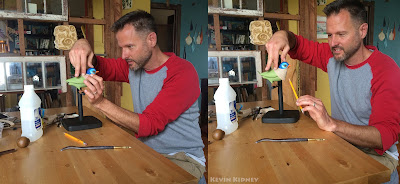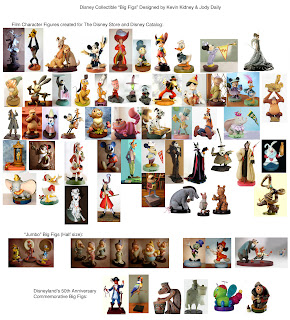 |
| Original 1963 Tiki Room animatronic "robin" |
It's a special treat to get up-close-and-personal with these beautiful little figures. For several years I've had the great fun of "figure finishing" some of Disney's historic Audio-Animatronic characters, both internally for the Disney Company and for private collections. Tiki Room birds are my favorite, mainly because of their small size, and because I'm such a fan of the attraction's design. The mechanized cast of Walt Disney's Enchanted Tiki Room in Anaheim consists of 77 birds, 136 flowers and 12 tiki drummers (not to mention several chanting totems). Each figure is a work of whimsy and craftsmanship.
 |
| Original robin figures being assembled at WED, vintage photo |
The smallest talents in the show are the "robins" (there are 20 of 'em) perched in cages suspended from the woven mat ceiling of the theater. They really are quite tiny and, I think, easily overlooked. Compared to the more sophisticated animation of Jose and the other "Master of Ceremonies" macaws, the robins perform very subtle functions. Heads turn, beaks open, tail feathers twitch, and some of the robins can flap their wings. They have just enough life spark to convincingly do their job as chorus members.
Recently I restored two original 1963 robins, one after the other, that had been retired from the show decades ago. They both had the fiberglass bodies used in the early California and Florida shows. In the 1980s, a new generation of birds sporting bodies made of lightweight Kydex were developed for Tokyo Disneyland. The Anaheim show today is a mix of old and new bird performers.
 |
| Creating the fur patterns in our studio |
Both robins arrived at our studio in pretty bad shape, with soiled fur, overly-handled feathers, and fiberglass parts gritty from too many coats of paint and hardened glue. The photos below were shot after a weeklong deep cleaning inside and out, priming and painting. I built display perches and replaced the birds' missing feet. I removed their back panels and thoroughly cleaned the inner-workings.
 |
| Wingless robin with moving head |
It's amazing how much is packed into the interior of a tiny bird. Two rubber hoses, each roughly the thickness of a spaghetti noodle, carry air pressure through the bird's legs into the two cylindrical chambers in his body. The left cylinder operates the tail, and the right cylinder turns the head side to side .
The next photo is a different robin with slightly different functions.
 |
| Robin with moving wings and tail |
For this variation, the tail moves, but not the head. Instead the right cylinder pushes open the wings which are hinged at the shoulder. Black electrical wires lead to the head where audio impulses synched to the show's soundtrack would operate a tiny magnet behind the lower jaw, making his beak open and close. When the five robins in each birdcage are moving together, the resulting performance seems choreographed to the music.
 |
| Pardon me, buddy, your little black wires are showing. |
 |
| Restoration complete and ready to tweet. |
With the addition of fur cloth and feathers sourced from Disneyland's original supplier, the birds really come to life. Chicken hackles for a jaunty topknot, coque feathers for the forked tails, and wings adorned with duck quills dyed green and pre-sorted for their natural left side/right side curves. It takes care and patience to do a nice job.
The Tiki Room's avian actors were sculpted in 1962 by Blaine Gibson, based on Marc Davis's drawings. Engineers Roger Broggie and Bob Gurr devised the inner workings and perches for each bird, and the resulting figures were taken to show-quality appearance by three supremely talented women: Harriet Burns, Leota Tooms, and Glendra von Kessel. I was so lucky to meet Blaine and Harriet in the '90s and learn from them about their work on these fanciful creatures—"based on nature but styled for drama." I'm immensely grateful for the rare opportunity to take on a project like this. The best part is just being able to spend a little time enjoying these great characters in detail.












